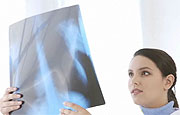
TUESDAY, Oct. 23 (HealthDay News) — Warning labels do little to prevent children from swallowing high-powered magnets that can tear holes in the stomach and bowel and cause severe, life-threatening complications, a new study found.
It found that there have been at least 480 cases of infants, children and teens in the United States who swallowed high-powered magnets in the past 10 years. Of those cases, 80 percent of the patients required surgery or an endoscopic procedure.
The majority (51 percent) of magnet ingestions occurred in children aged 1 to 6, although cases also occurred among older children and teens, who use the magnets to mimic lip, nose and tongue piercings.
The findings are from more than 350 pediatric gastroenterologists who responded to a August survey distributed by the North American Society for Pediatric Gastroenterology, Hepatology and Nutrition (NASPGHAN).
High-powered magnet sets were introduced as a consumer product in 2008 and generally marketed as adult desk toys. They are commonly sold in sets of 100 or more balls that are about 3 to 6 millimeters in size.
The magnet sets were initially labeled for use by people aged 13 and older, but since 2010 have been labeled for use by people age 14 and older. Most of the sets include warnings to keep the product away from children.
However, this survey showed that ingestion of high-powered magnets by children and resulting injuries continue despite warning labels.
If a child swallows more than one of these magnets, the magnets will attempt to connect with each other inside the body. In doing so, the magnets can tear holes in the stomach and bowel.
“Ingesting two or more of these super-strength magnets is unlike swallowing a marble or other small foreign body,” Dr. Athos Bousvaros, NASPGHAN president, said in a society news release.
“Damage from these magnets begins soon after ingestion. When the intestinal wall separates two or more magnets that attract each other, holes in the bowel can occur. Time is of the essence with a high-powered magnet ingestion. Yet, bowel damage can be difficult to diagnose, especially in toddlers who can’t convey they have swallowed magnets,” Bousvaros said.
The findings were presented at a news conference on Tuesday.
A child-injury prevention specialist is working to eliminate the products altogether.
“As the Consumer Product Safety Commission pushes toward a ban of these high powered magnets, we should realize the magnitude of this push,” said Jennifer Hoekstra, the Safe Kids Program Coordinator at Helen DeVos Children’s Hospital in Grand Rapids, Mich.
“This aggressive movement highlights
the danger that these small powerful magnets bring into our homes,” Hoekstra said. “These magnets are not intended to be where children can access them, and the warning labels do not seem to be enough. If parents have these small, powerful magnetic items in the home, they should be kept out of reach of children — or better yet, locked up with the poisons.”
More information
The U.S. Consumer Product Safety Commission has more about the dangers of high-powered magnets.

